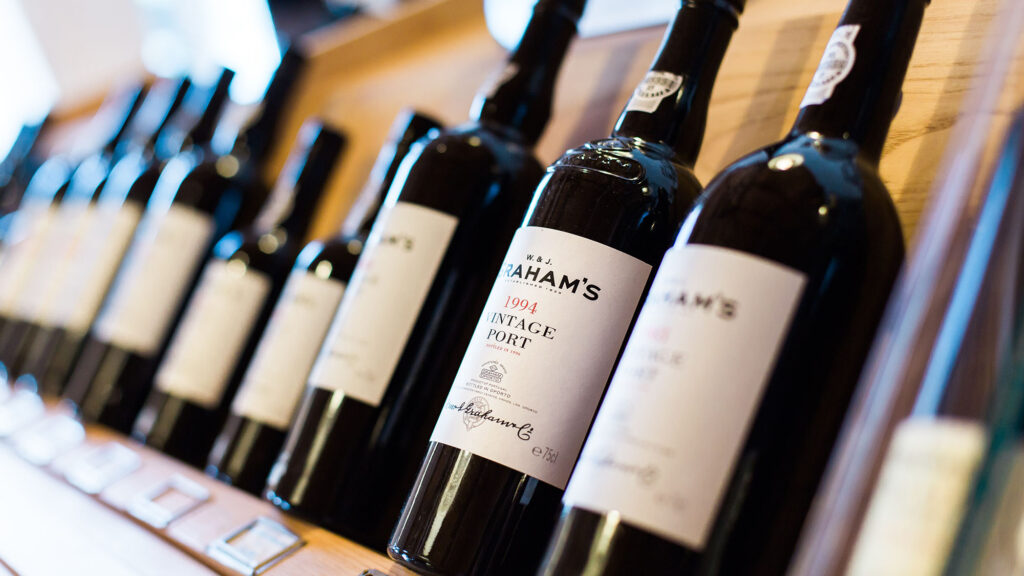We get it – wines can be confusing. Especially if you are new to the world of wine, it can feel as if everything tastes the same, but you must learn to observe the subtle differences. Muscat and Port are two types of wine that are often confused for each other but are not interchangeable. So, how are Muscat vs. Port different?
The most important difference between Muscat vs. Port is what grapes they are produced from. Port grapes are grown and cultivated in the Douro region of Portugal, while grapes for Muscat wines are grown worldwide.
Although both these wines are a beloved dessert of many people, there are quite a few differences between them.
Let’s take a closer look!
Muscat
History of The Grape
Although there isn’t much evidence, many historians believe that the origins of the Muscat grape family date all the way back to ancient antiquity cultivated by civilizations like the Egyptians.
Experts in the area state that the ancient Persians first discovered Muscat grapes (c. 3000-1000 BC), while others believe that this grape variety was first cultivated in the period known as classical antiquity (c. 800 BC to 600 AD) by the Greeks and Romans.
Muscat grapes are very sweet, and classical writers such as Columella have described “muscat-like” grape varieties like Anathelicon Moschaton and Apianae that were very attractive to bees, but due to the lack of technologies, there is no solid proof that these belonged to the family.
The first official mention of grapes named “muscat” was in the papers of the English scholar Bartholomeus Anglicus who wrote about wine made from Muscat grapes in his work “De proprietatibus rerum.” This mention dates back to around 1235, while Anglicus was doing research in what is now Germany. He described this wine as “vin extrait de raisins muscats.”
Where Does the Name Muscat Come From?

Because the Muscat grape family’s precise historical origins aren’t known, there are a few theories as to how it got its name. The most commonly believed one is that the name is derived from the Iranian word muchk.
Author Note: Similar roots point to the Greek word moskos, Latin word muscus, and French word musc. In Italy, the word mosca, meaning fly, could also be a possibility since these grapes’ sweet aroma and sugar levels are a common attractant for insects like fruit flies.
Other theories say that the grape is originally from the Arabian Oman country and was named after the city of Muscat, which lies on the coast. Another city that is suggested as the potential birthplace of this grape family is the Greek Moschato found southwest of Athens.
This is “proven” by the fact that Moschato is a common synonym in Greek for Muscat grapes.
Muscat Wine Types
The Muscat wine family includes Moscato wines as well. These are the Italian version of muscat blanc grapes. It generally has a perfumed aroma and a fruity profile with hints of orange, pear, and honeysuckle. These are other varieties of Muscat wine made by combining Moscato Blanc and other grapes during the fermentation phase.
Still Moscato
By cultivating Muscat of Alexandria grapes, winemakers can form a similar flavor profile to the Moscato Blanc, which is drier but sweeter. It also has a strong aromatic palette of fruits.
Pink Moscato
Pink Moscato is made by mixing Alexandrian, Austrian, or Italian Muscat with some Merlot to make it a pretty pink color. The Merlot also adds to the flavor, but Muscat grapes’ natural fruitiness creates notes of strawberry flavors. Yum!
Black Muscat
There’s a rare sort of Muscat grape that makes for a rich dark wine called Red Moscato, or Black Muscat. This grape is a cross between the Italian Schiava and the Alexandrian Muscat. It forms a rich flavor profile with hints of raspberry, violets, and black tea.
Muscat Flavor Profile
Muscat wine, unlike most dry white wines, generally has a very sweet and fruity flavor. When these grapes are crossed and mixed with other varieties during the fermentation process, the wine’s sweet flavors take on a completely new dimension.
What does this mean for you? You won’t have any difficulty finding the perfect pairing for this wine, so let’s get to some matches!
Muscat Food Pairings
As mentioned above, Muscat goes well with almost everything, but there are a few food options that are preferred. As with most wines, cheese is a wonderful pairing.
Because of this wine’s fruity and floral aroma, sharp and strong cheeses like Bleu and other French cheeses will help bring out the pear, citrus, and apple flavors that characterize Muscat wine.
The sweet and floral notes of Muscat wine also go beautifully with spicy dishes. Serving Indian or Thai food at your next dinner party will help bring out Muscat’s spicy, rich flavors and aromas.
Muscat also makes the perfect dessert wine! The drier, fruitier flavors go well with baked apple pie, caramel, and ice cream bringing up the acidic hints in the fruit. For richer tastes, black Muscat goes well with caramels, chocolate, cherries, raspberries, and blackberries.
Whatever your favorite guilty pleasure, Muscat is sweet enough to take you there!
Port

Now it’s time to move on to Port wine, a Portuguese dessert wine made with red and white grapes and also some brandy for fortification. Producers use different periods of aging and mixing to reach the captivating aromas and delicious flavor that goes much beyond just “sweet.”
Where Is Port Wine From?
Author Note: Port wine is made in the region of the Douro Valley in Portugal. This wine production is concentrated in cities near Douro River, such as Vila Nova de Gaia and Porto (home to Taylor Fladgate, Graham’s, and Cockburn’s), where grapes are still being crushed by feet.
Similar to the naming rules concerning Champagne, EU law states that a Port must be made in Portugal in order to be sold using this name. Because these regulations only apply inside the EU, Portuguese producers include a certification seal on the bottles to prove the legitimacy.
How Is Port Made?
After the first fermentation stage, the base wine is then fortified using brandy to stop the process and capture the aromas at their peak. This also maintains a higher percentage of residual sugars than normal, which provides port wine its sweetness and high alcohol content. Then, the Port is moved to casks—or, sometimes, straight to bottles—for up to two years, and then it can be mixed with other vintages or left to age more.
What Does Port Wine Taste Like?
All port wines are sweet, but depending on the grapes used in production and how long they have aged, there can be different shades of sweetness in each bottle.
Port has a medium tannin level with hints of ripe, musky berries such as raspberry and blackberry, buttery caramel, and bitter chocolate. Older ports have concentrated hints of dried fruit, while younger ones taste like lighter-bodied red fruits such as strawberries.
4 Styles of Port Wine
Here are the main types of Port:
Ruby
Made using red wine grapes native to Portugal like Touriga Franca, Touriga Nacional, and Tinta Barraco, a ruby port is an affordable option with bright and fruity flavors for a fun afternoon. Reserve ruby port is the more premium variant of this wine and is meant to be consumed young. Late bottled vintage (LBV) port should also be drunk after a short aging period of around five years. Bottles with a “crusted” label are used to show that the wine is a blend of more than one vintage year; meanwhile, “single quinta” means a vintage port is from a single estate.
Rosé
Of course, rosé port is still technically a ruby port; there is just less skin contact to maintain a paler color like in standard rosés; it is still a distinct newbie in the Porto portfolio. Rosé Port is on the lighter end of the red fruit pallet with hints of strawberry, raspberry, and cranberries, while the traditional ruby port is associated with ripe and dark fruits. Rosé should be served very well-chilled!
White

Author Note: Made using white grapes such as Rabigato, Viosinho, and Gouveia, white port wines taste mainly of stone fruits like apricot and white peach along with some lemon peel. White Port is less well-known in countries like the United States; in Porto, it is normally topped off using tonic as an aperitif or added into cocktails.
Tawny
Tawny Port is a red wine that has barrel-aged for a longer period of time, leading to an amber color and a more complex flavor palette. Aged Tawny Port is bottled in 10-, 20-, 30-, and 40-year increments, showcasing all the flavor signatures of oxidized wines: Warm spices, hazelnut, and dried fruits such as dates, figs, and prunes. The longer tawny ports age, the deeper they turn; a 40–year old tawny, leans into the flavor of pure vanilla spice and turns caramel into something like butterscotch.
Foods Pairings with Port Wine
Port is famously known as a dessert wine, and not just because of its sweetness. It is best paired with bold dishes, ingredients, and flavors, and these usually show up at the end of a meal. Aged cheeses, Black Forest cake, and vanilla ice cream; anything that accentuates the aged tawny caramel and chocolate notes is a good option. Ruby ports also go well with roasted meats, mixing up fruity acidity with rich, smoky, and salty flavors.
Wrapping Up
Today we learned about two distinct wines that may be similar in their sweetness yet are very different in everything else. So, next time someone confuses Port and Muscat, be sure to point out their mistake and showcase your wine connoisseur knowledge.
We hope you enjoyed this article on Muscat vs. Port. A toast of sweet dessert wine to health and success in the new year!
To living a full-bodied life,
Wesley

